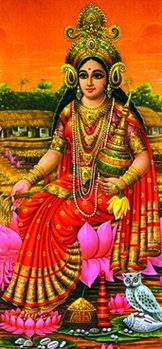Laksmi Puja
Laksmi Puja a religious festival of Hindus, celebrating Laksmi, the goddess of prosperity and good fortune. The Rg Veda refers to her as the goddess of beauty and wealth. The Taittiriya Sanghita depicts Laksmi and Sri as the two wives of Aditya. According to the Shatapathabrahmana, she emerged from Prajapati, while according to the ramayana, she emerged from the sea with a lotus in her hand.

Laksmi is also referred to as Kamala, Gajalaksmi and Mahalaksmi. She is depicted variously, with two or four arms. Seated on a lotus, she holds a lotus in her hand. Her vahana (mount) is the owl. Laksmi Puja is held on the full moon following durga puja. It is believed that on this night, the goddess visits houses to distribute blessings, rewarding those who keep awake the whole night worshipping her. This worship is called Kojagari Purnima or Kojagari Laksmi Puja because the devotees stay awake all night.
Some people also perform a special puja for Laksmi every Thursday. In some areas, Laksmi Puja is held at dusk on the day of the new moon in Kartik. Goddess Laksmi may be worshipped in the form of a statue or as a painted image on a pitcher or pot.
On the occasion of Laksmi Puja, alpana or floral designs are drawn with rice paste on floors and courtyards of houses, especially along the path from the door to the altar of the goddess and the cowshed. The path is often marked with tiny footprints-made by dipping rounded fists in rice paste and stamping the ground with them symbolising Laksmi's path. At the end of the puja, food is distributed. In some places, people pass the night playing dice, eating coconut and sweet balls made of fried or flattened rice, and drinking coconut water.
Laksmi is widely worshipped in West Bengal and Bangladesh. In every village home, there is a seat for Laksmi. In villages, fairs take place on the day of Laksmi Puja, where household goods and fancy objects are sold. boat races are also held in some places. [Suresh Chandra Banerjee]
